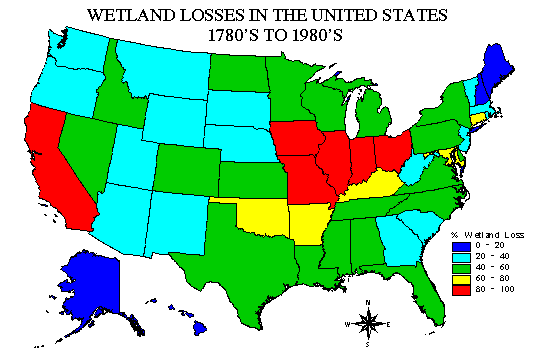Non-point source pollution creates many of the excess nutrients that eventually land in the Gulf of Mexico, helping the eutrophication process and thereby creating the dead zone. This pollution extends from states such as Ohio that rely on farming through river systems that empty into the gulf. Therefore, perhaps the most effective way to reduce eutrophication is at the source: agriculture nutrient run off . The most obvious and effective solutions would be to 1. Prohibit use of excess nutrients (such as fertilizer ) in farming, creating a sole practice of organic farming. This is neither cost-effective nor realistic. Secondly, the mitigation, creation or maintenance of wetlands to filter excess nutrients will drastically lower amounts of nitrogen and phosphorous entering the Gulf, as well as many other positive effects. According to the Committee on Environment and Natural Resources Hypoxia Work Group 13 to 18 million acres of both created and restored wetlands on the Mississippi River Basin would be necessary to filter anywhere from 50% to 70% of nitrogen runoff. Unfortunately, as of 1992, the Committee on Restoration of Aquatic Ecosystem created a 10 million acre target for the entire United States, to be completed by 2010. The United States Environmental Protection Agency (EPA) reports that the Gulf of Mexico states have lost thousands of acres of useful wetlands. Since 1870, Louisiana has lost 46% of their wetlands, going from 16,194,500 acres to 8,784,200 acres in 1980. Florida has also lost 46% of their wetlands, from 20,325,013 acres to 11,038,300 acres. Texas has lost 52% of wetlands, from 15,999,700 acres to 7,612,412 acres. Midwestern states, where farmers depend on agriculture for economic sustainability, have even higher rates of wetland loss. For example, from 1870 to 1980, Ohio has lost 90% of its natural wetlands. Mitsch (1999) documents that Indiana, Illinois, Iowa, Minnesota, Ohio and Wisconsin have a combined wetland loss of 35 million acres over the past 200 years, and suspects that perhaps without this high loss rate the Gulf of Mexico would not be suffering such high eutrophication rates. Because these states have lost their wetlands, agriculture runoff enters directly into rivers and straight through to the Gulf.



